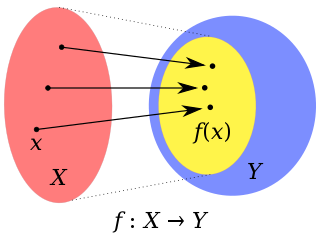
In mathematics, a binary operation or dyadic operation is a rule for combining two elements to produce another element. More formally, a binary operation is an operation of arity two.

In mathematics, an endomorphism is a morphism from a mathematical object to itself. An endomorphism that is also an isomorphism is an automorphism. For example, an endomorphism of a vector space V is a linear map f: V → V, and an endomorphism of a group G is a group homomorphism f: G → G. In general, we can talk about endomorphisms in any category. In the category of sets, endomorphisms are functions from a set S to itself.

Idempotence is the property of certain operations in mathematics and computer science whereby they can be applied multiple times without changing the result beyond the initial application. The concept of idempotence arises in a number of places in abstract algebra and functional programming.
In mathematics, an operator is generally a mapping or function that acts on elements of a space to produce elements of another space. There is no general definition of an operator, but the term is often used in place of function when the domain is a set of functions or other structured objects. Also, the domain of an operator is often difficult to characterize explicitly, and may be extended so as to act on related objects. See Operator (physics) for other examples.
In mathematics, a partial functionf from a set X to a set Y is a function from a subset S of X to Y. The subset S, that is, the domain of f viewed as a function, is called the domain of definition or natural domain of f. If S equals X, that is, if f is defined on every element in X, then f is said to be a total function.

In mathematics, the domain of a function is the set of inputs accepted by the function. It is sometimes denoted by or , where f is the function. In layman's terms, the domain of a function can generally be thought of as "what x can be".
Distributions, also known as Schwartz distributions or generalized functions, are objects that generalize the classical notion of functions in mathematical analysis. Distributions make it possible to differentiate functions whose derivatives do not exist in the classical sense. In particular, any locally integrable function has a distributional derivative.
In mathematics, an algebraic structure consists of a nonempty set A, a collection of operations on A, and a finite set of identities, known as axioms, that these operations must satisfy.

In mathematics, a function from a set X to a set Y assigns to each element of X exactly one element of Y. The set X is called the domain of the function and the set Y is called the codomain of the function.

In mathematics, the range of a function may refer to either of two closely related concepts:
In mathematics, more specifically in topology, an open map is a function between two topological spaces that maps open sets to open sets. That is, a function is open if for any open set in the image is open in Likewise, a closed map is a function that maps closed sets to closed sets. A map may be open, closed, both, or neither; in particular, an open map need not be closed and vice versa.

In mathematics, if is a subset of then the inclusion map is the function that sends each element of to treated as an element of
In logic, a truth function is a function that accepts truth values as input and produces a unique truth value as output. In other words: the input and output of a truth function are all truth values; a truth function will always output exactly one truth value, and inputting the same truth value(s) will always output the same truth value. The typical example is in propositional logic, wherein a compound statement is constructed using individual statements connected by logical connectives; if the truth value of the compound statement is entirely determined by the truth value(s) of the constituent statement(s), the compound statement is called a truth function, and any logical connectives used are said to be truth functional.

In mathematics, the restriction of a function is a new function, denoted or obtained by choosing a smaller domain for the original function The function is then said to extend
The Stanford Research Institute Problem Solver, known by its acronym STRIPS, is an automated planner developed by Richard Fikes and Nils Nilsson in 1971 at SRI International. The same name was later used to refer to the formal language of the inputs to this planner. This language is the base for most of the languages for expressing automated planning problem instances in use today; such languages are commonly known as action languages. This article only describes the language, not the planner.
In mathematics, Church encoding is a means of representing data and operators in the lambda calculus. The Church numerals are a representation of the natural numbers using lambda notation. The method is named for Alonzo Church, who first encoded data in the lambda calculus this way.
In universal algebra and in model theory, a structure consists of a set along with a collection of finitary operations and relations that are defined on it.

In mathematics, an operation is a function which takes zero or more input values to a well-defined output value. The number of operands is the arity of the operation.
In mathematics, the qualifier pointwise is used to indicate that a certain property is defined by considering each value of some function An important class of pointwise concepts are the pointwise operations, that is, operations defined on functions by applying the operations to function values separately for each point in the domain of definition. Important relations can also be defined pointwise.
In logic, especially mathematical logic, a signature lists and describes the non-logical symbols of a formal language. In universal algebra, a signature lists the operations that characterize an algebraic structure. In model theory, signatures are used for both purposes. They are rarely made explicit in more philosophical treatments of logic.










